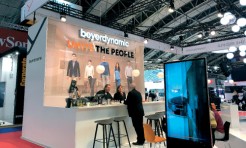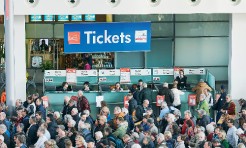How can exhibitors use a trade fair app for their marketing?
Trade fair apps offer new functions that allow exhibitors to use technology to play an active role in shaping their entire trade fair appearance. As a result of the triumphant advance of the smartphone, these apps are becoming increasingly popular with trade fair visitors.

Expert: Sabrina Reinhardt
Sales and Marketing
Heidelberg Mobil International GmbH
A variety of options
In the month to two weeks before a trade fair starts, the number of times the event’s app is accessed and downloaded increases significantly. The alphabetical and product-specific lists of exhibitors are used particularly often, as are the maps of the site and exhibition halls. The app allows the trade fair company to offer exhibiting companies a variety of products to help them with their trade fair marketing. There is generally a product to suit every budget, which means that every exhibitor can benefit from the trade fair app.
Banner sponsorship
Banner sponsorship is a tried-and-trusted form of advertising. The advertising banner appears on almost every page of the app and can be linked to different kinds of pages. For example, the banner can be linked to an external website – the company’s home page, for example, or a microsite created specifically for the purpose of an advertising campaign. Another option is a landing page: instead of a direct link to the exhibitor’s home page, the user is first taken to a landing page within the app that contains detailed information and images. The advantage of a landing page like this is that no connection to the Internet is required to display it. The user receives the essential information about the company or specific products and can proceed to the company’s home page via a link.

Clickable logo
Small and medium-sized companies with limited budgets can highlight their stand on the map of the exhibition hall by adding their company logo to it. The exhibitor’s logo attracts considerably more attention than just the company’s name.
Interstitials
At certain points – while a page is loading, for example – it is possible to display full-screen advertisements known as interstitials. These appear for around three seconds and then automatically disappear again. Interesting graphics attract a great deal of attention from users. It is also possible to include a link to the company’s home page on in the interstitial.
In-app apps
In-app apps are particularly suitable for larger companies or shared stands. Facts and figures, news, a map of the stand, a company profile, social networks or videos can be displayed in an app integrated in the trade fair app. The visitor can navigate through the exhibitor’s content section by section and get a comprehensive picture of what the exhibitor has to offer. A prominent example of this is the interactive IBM stand, which is part of the CeBIT app.
Range of benefits
Trade fair apps offer a range of benefits for exhibiting companies’ marketing. These include measurable coverage, low wastage, independence of time and place, a high level of acceptance, long campaign durations, value for money and – something that’s particularly important – measurement of results on the basis of detailed analyses. In terms of the placement of the advertising, there is a clear focus on user behaviour. Rather than being overloaded with advertising, the app serves as an exclusive medium with a maximum of five banner locations. Moreover, strict attention is paid to avoiding overt competition between exhibitors. For example, no advertising is permitted within an exhibitor’s detailed entry. As a general principle, the information obtained on user behaviour around each trade fair is exploited in the development of subsequent apps. Apps that are well received and used a lot by trade fair visitors are developed further . On the other hand, options that are little used are discontinued.
Heidelberg Mobil developed over 50 apps for trade fairs and conventions in 2012. These included major events such as IAA, IFA, CeBIT and Hannover Messe as well as smaller trade fairs and conventions of various magnitudes (www.heidelberg-mobil.com).
This article was published in TFI issue 5/2013
Share in Facebook, Twitter or Google+:
TFI - Trade Fairs International - The International Trade Fair Magazine.
© 2006 - 2024 by TFI-Verlagsgesellschaft mbH. All rights reserved. TFI-Verlagsgesellschaft mbH shall accept no responsibility for the contents of external links and other contents.
TFI-Know-how
-
What to do when things go wrong at virtual or in-person events?

In the event world, it’s simply part of life if things don’t work out as planned.
-
How can networking be made to work at online events?

Networking typically happens at real, in-person events. But it’s also possible to do it online; it just works a little differently. There are various options available to organisers.
-
How can exhibitors stand out at trade fairs?

New products and a well-conceived stand design are not the only drivers for a successful presence. Many other factors are also important, but trade fair planners often lose sight of them.
-
How can industry decision-makers be reached online?

Trade fairs and trade fair companies need to constantly further develop, become more agile and flexible and offer services all year round. New, digital offerings are very important here. With its TrustedTargeting technology, Messe München offers its customers access to leading business-to-business decision-makers on the Internet.


